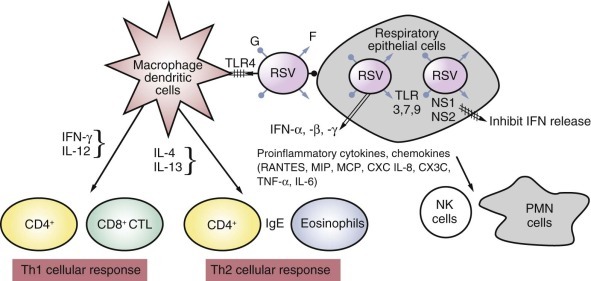FIGURE 160-4.

Early innate and adaptive immunity response to respiratory syncytial virus (RSV).
RSV's envelope glycoprotein G attaches to the respiratory tract epithelial cells by glucosamine glycans expressed on the cell surface, and F interacts with antigen-presenting cells (macrophages, dendritic cells) through Toll-like receptor 4 (TLR4) protein. This triggers the production and release of antiviral interferons (IFN-α, IFN-β, IFN-γ) and a cascade of proinflammatory cytokines and chemokines. Two early nonstructural RSV gene products (NS1, NS2) antagonize interferon production. The chemokines recruit polymorphonuclear neutrophils (PMN cells), natural killer (NK) cells, and CD4+ and CD8+ T cells. A Th1-type cellular response becomes dominant under the influence of IFN-γ and interleukin-12 (IL-12), whereas under the influence of IL-4 and IL-13, the cellular response is skewed toward Th2, with the production of immunoglobulin E (IgE) and eosinophils. CTL, cytotoxic lymphocyte; CXC, cysteine X cysteine; MCP, monocyte chemotactic protein; MIP, macrophage inhibitory protein; RANTES, regulated on activation, normal T-cell expressed and secreted.
(Modified from Hall CB, Walsh EE. Respiratory syncytial virus. In: Feigin R, Cherry J, Demmler G, Kaplan S, eds. Textbook of Pediatric Infectious Diseases. 6th ed. Philadelphia: Saunders; 2009:2462-2487.)
